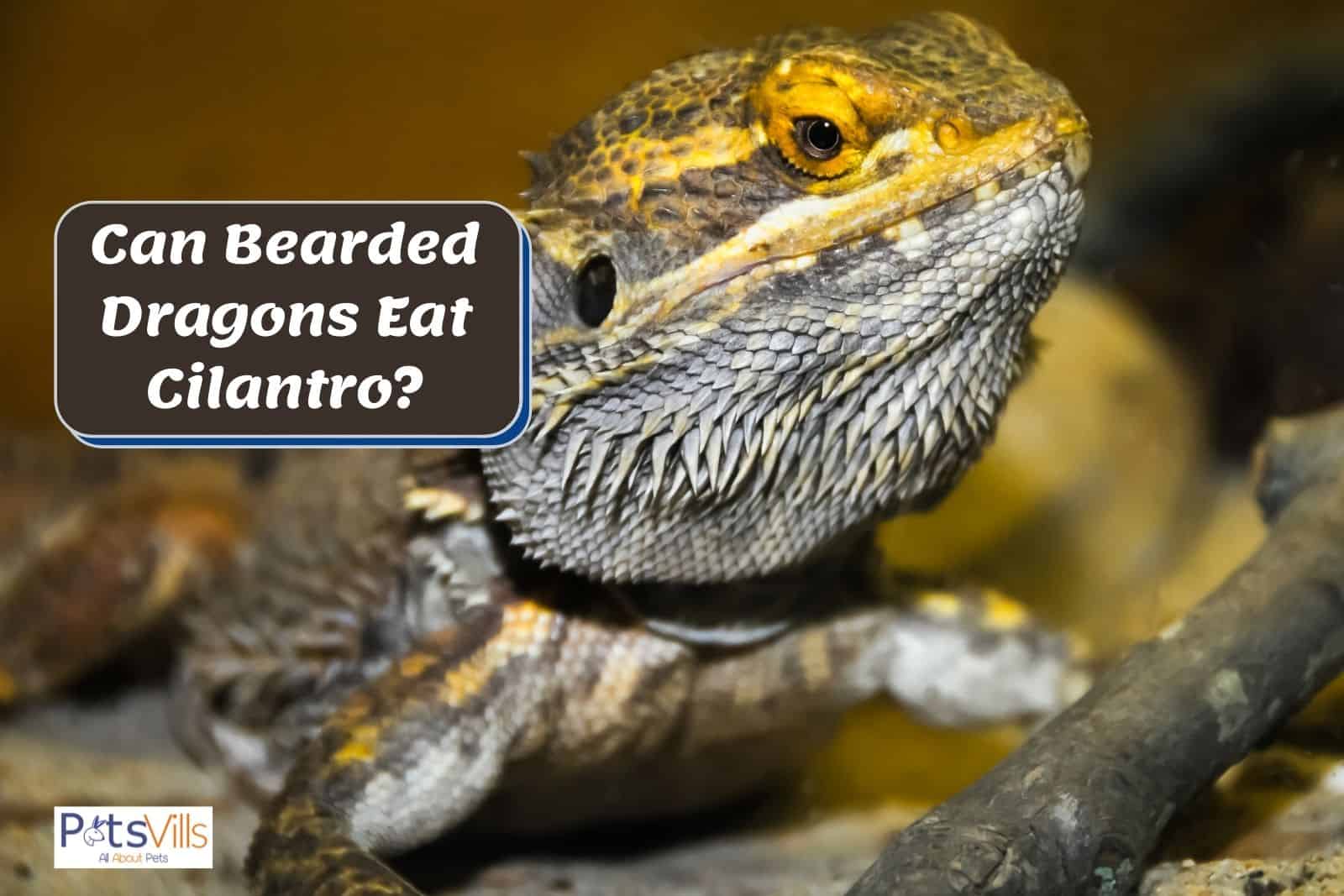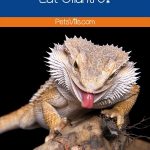Can bearded dragons have cilantro?
As any owner knows, feeding your beardie a proper diet requires a ton of research.
Just when you think you’ve got it all figured out, you come across another veggie, fruit, or – in this case- an herb and find yourself wondering if it’s a good addition.
Join us as we take an in-depth look at whether cilantro can form a part of a healthy diet for your beardie.
This post contains affiliate links. We earn a commission if you make a purchase after clicking on our links.
Don’t have time? Check this comparison table of our top faves!
READ MORE: Best Live Foods for Bearded Dragons
Table of Contents
Can Bearded Dragons Eat Cilantro?
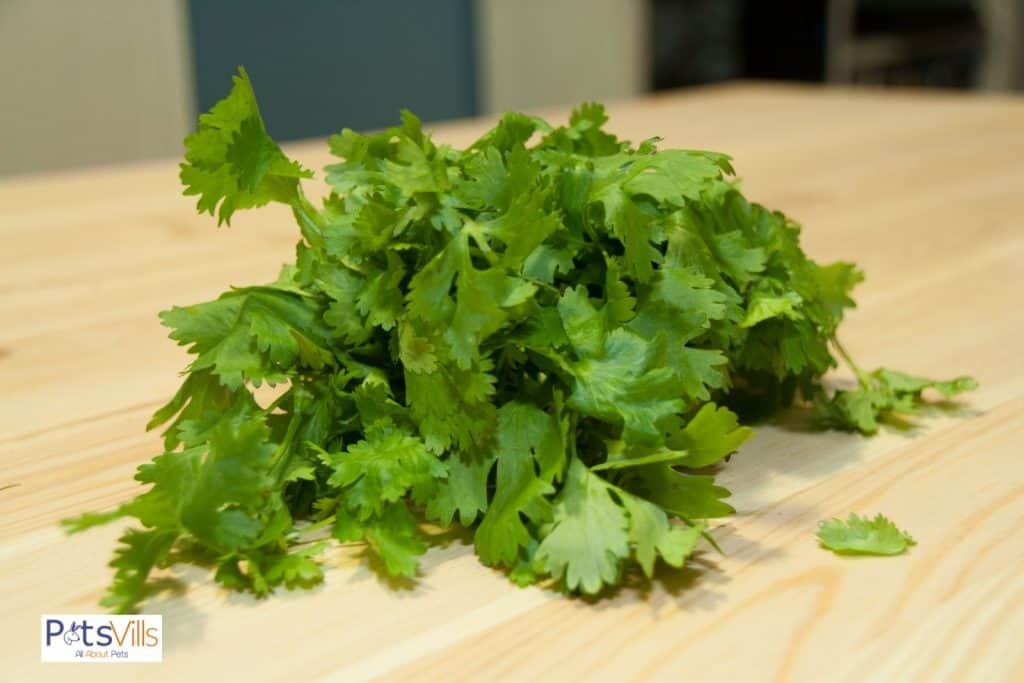
Yes, you can feed your bearded dragon cilantro. It is non-toxic, contains virtually no sugar, and has high water content.
Cilantro, a popular fresh leafy green, also known as Chinese parsley or coriander is actually one of the safest herbs to give a dragon.
That said, its nutritional components make it a less ideal green to add to your beardy’s list of staple foods.
You could add a pinch of cilantro to your bearded dragon’s daily food bowl, but there are a couple of reasons that you should save it for special occasions.
While there is nothing inherently unhealthy about fresh cilantro, the excess water could lead to overhydration which can give your dragon diarrhea.
Also, compared to many other leafy greens, like kale, cilantro is relatively low in nutritional value.
Unlike many other fruits and fresh vegetables, there is no hard limit on the frequency with which you can add a bit of cilantro to your dragon’s daily meal.
Younger plants generally contain less oxalic acid. Because of this, it is always best to feed your beardy the freshest sprigs, fresh leaves, and remove any leftovers from their food bowl before they wilt.
It is important to wash cilantro off with fresh water to remove any larger amounts of potentially harmful toxins from the plant.
Can Bearded Dragons Eat Cilantro Stems?
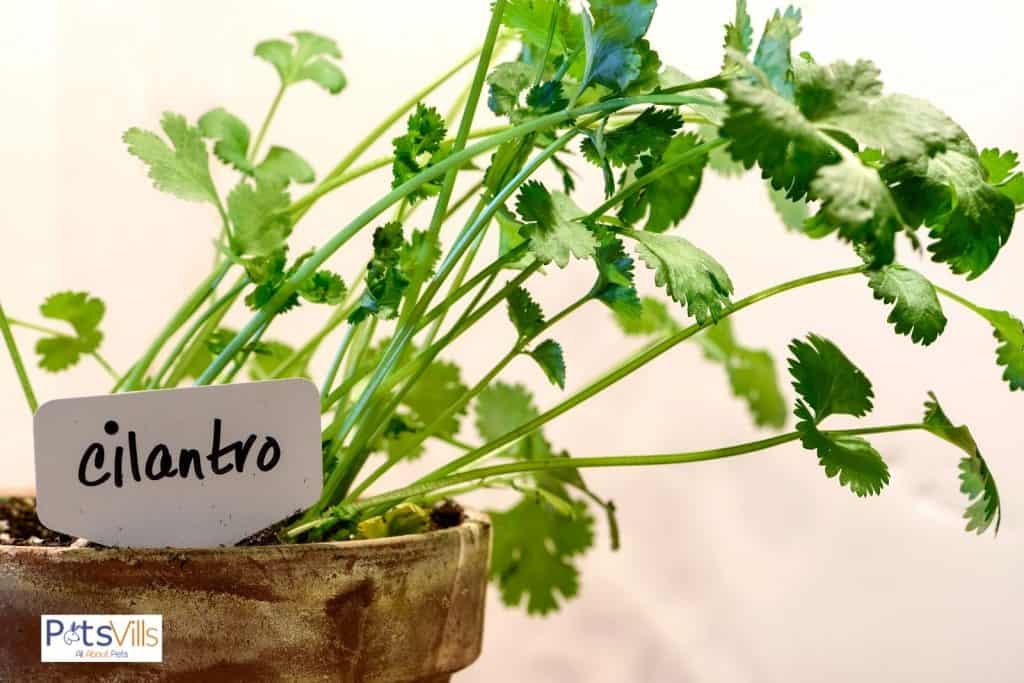
There is no part of fresh cilantro that poses a dietary risk to bearded dragons, so they can safely eat cilantro stems.
Cilantro even produces edible flowers.
That said, most lizards, including beardies, are ill-equipped to eat the tougher parts of plants, such as stems and roots.
Foods that are difficult to digest can lead to digestive issues. Therefore, it is best to stick with the cilantro leafy greens, and flowers to avoid choking.
Even then, it would be best if you finely chopped the leaves and flowers.
You could use a kitchen knife to chop or dice the stem as a special treat in a pinch. Unfortunately, there is not enough data on whether the cilantro root is completely safe for beardies.
Dried cilantro, commonly referred to as coriander, is a no-go. Dried herbs are harder for dragons to digest and can lead to digestive health problems. It is best you always give your dragon fresh produce.
READ THIS: What Veggies Can Bearded Dragons Eat?
Benefits Of Cilantro for Bearded Dragons
Cilantro has several possible health benefits when added to a nutritious, balanced bearded dragon diet. These include:
Vitamin C
According to Nutrition Data, a gram of cilantro contains roughly 0.6 mg of vitamin C. That means that cilantro can go a long way in supplementing a beardie’s s weekly vitamin C requirements.
A dragon’s vitamin C requirements vary between subspecies of bearded dragons, as well as size, weight, and age.
You may already dust your dragon food with calcium powder. Therefore, it is best to consult your vet to determine your beardie’s calcium requirements.
Vitamin A & Vitamin K
Feeding bearded dragons cilantro in moderation is a good source of moderate amounts of vitamin A. That makes it a perfect additive to a balanced beardie diet, as too much vitamin A can be toxic.
Likewise, cilantro is an excellent source of vitamin K. The additional vitamin K provided from a dash of cilantro aids in healthy blood clotting. It also helps in regulating blood calcium levels and healthy bone development.
Low Levels of Oxalic Acid
Oxalic acid, also referred to as oxalates, is a chemical that occurs naturally in plants and forms a part of their biological defense system.
To keep your dragon healthy, high-oxalate foods should account for less than 10% of your dragon’s daily diet.
Cilantro is considered low in oxalates, containing only about 0.01 mg per 100 grams.
Dangers of Cilantro for Bearded Dragons
Although generally a safe herb, cilantro does have some downsides and dangers. Let’s take a look.
High Water Content
Cilantro is about 92% water. This means a bit of it, fed in moderation is a great source of hydration.
However, because bearded dragons evolved in desert habitats, too much this can cause overhydration and diarrhea. Diarrhea, in turn, can lead to dangerous levels of dehydration.
Calcium-to-Phosphorus Ratio
Calcium is important for strong bones. Therefore you should always consider the levels and ratios of nutrients like calcium and phosphorus in your beardy’s diet.
The ratio should always favor the calcium level to avoid health risks like kidney stones.
In addition, a calcium-to-phosphorus ratio in favor of phosphorus can lead to a serious condition called metabolic bone disease. MBD has serious implications for bone growth and health.
When people ask, “can bearded dragons eat apples?” or “can bearded dragons eat cucumber?” it is usually out of concern for the phosphorus contents.
Cilantro does meet this criterion. It also contains decent amounts of calcium.
A single apple contains 10 mg of phosphorus, while cucumber contains around 29.8 mg per 100 grams. This gives is a Ca:P ratio of 1.4:1, which is nearly ideal.
How Much Cilantro Can We Feed to Bearded Dragons?
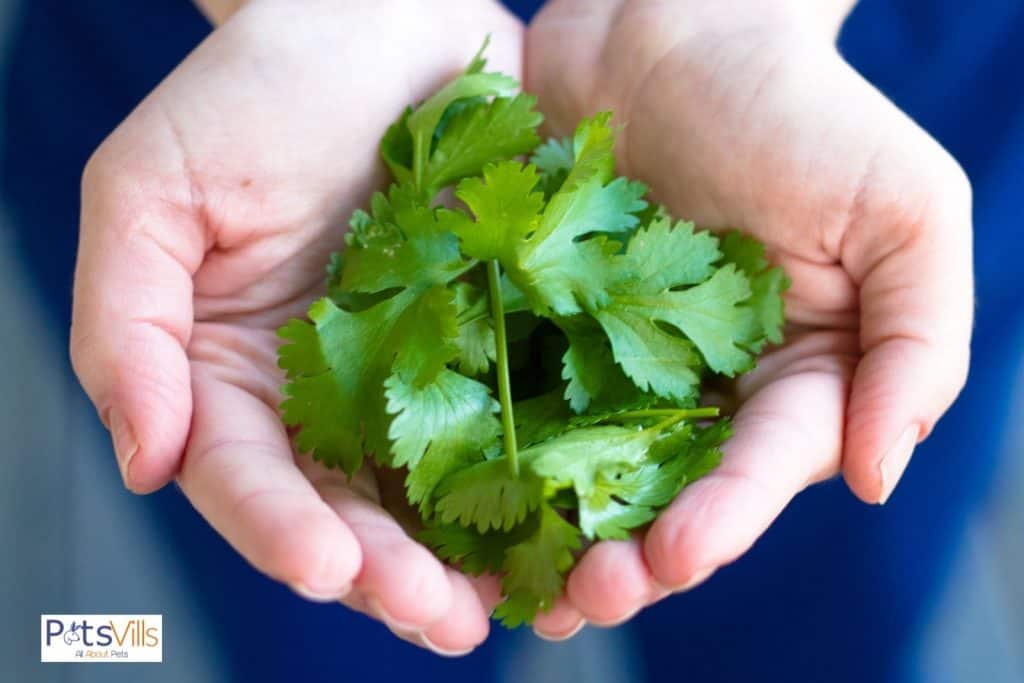
While cilantro is perfectly safe in larger quantities, you should serve your beardie no more than a modest pinch in their daily diet, or a few sprigs a few times a week.
Try to keep it under three sprigs per bowl of greens. Fresh foods are always best, and any canned cilantro or cooked cilantro is best avoided.
Purchase our new e-book to help you prepare your beardie’s proper diet:
FAQs
How often can bearded dragons eat cilantro?
In very small servings of around 5-8 cilantro leaves, it is safe to feed your dragon bite-sized pieces of the herb daily. However, as an addition to a balanced diet, cilantro is best reserved for an occasional treat served a couple of times a week.
What herbs can I feed my bearded dragon?
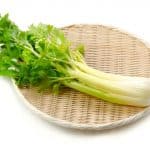
Coriander is an excellent herb for your baby beardie in small quantities, but it is not the only one. Some herbs can even be grown inside bearded dragon tanks! Several fresh herbs are safe for beardies, including:
Basil
Bay Leaves
Celery
Chives
Fresh dill leaves
Fennel
Lavender
Parsley
Rosemary
Sage
Homegrown herbs are the safest way to avoid toxic pesticides.
Conclusion
In short, beardies can eat cilantro. While there is no serious health risk in occasionally feeding them a larger serving, a pinch of the herb added to their staple greens is the healthiest option.
References
- Andy. 2013. “Health Benefits of Cilantro and Coriander Seeds – the Paleo Gut.” The Paleo Gut. December 9, 2013. http://thepaleogut.com/fruit-vegetables/health-benefits-cilantro-coriander-seeds/.
- “Bearded Dragons: Common Husbandry and Nutrition-Related Problems.” 2014. Veterinary Nursing Journal. 2014. https://www.tandfonline.com/doi/abs/10.1111/vnj.12190.
- Kubiak, Marie. 2020. “Bearded Dragons.” Handbook of Exotic Pet Medicine, August, 219–40. https://doi.org/10.1002/9781119389934.ch13.
- Prasad, Rajendra, and Shivay, Yashbir Singh. 2017. “Oxalic Acid/Oxalates in Plants: From Selfdefence to Phytoremediation.” Current Science 112 (8): 1665–67. https://www.jstor.org/stable/44211898.
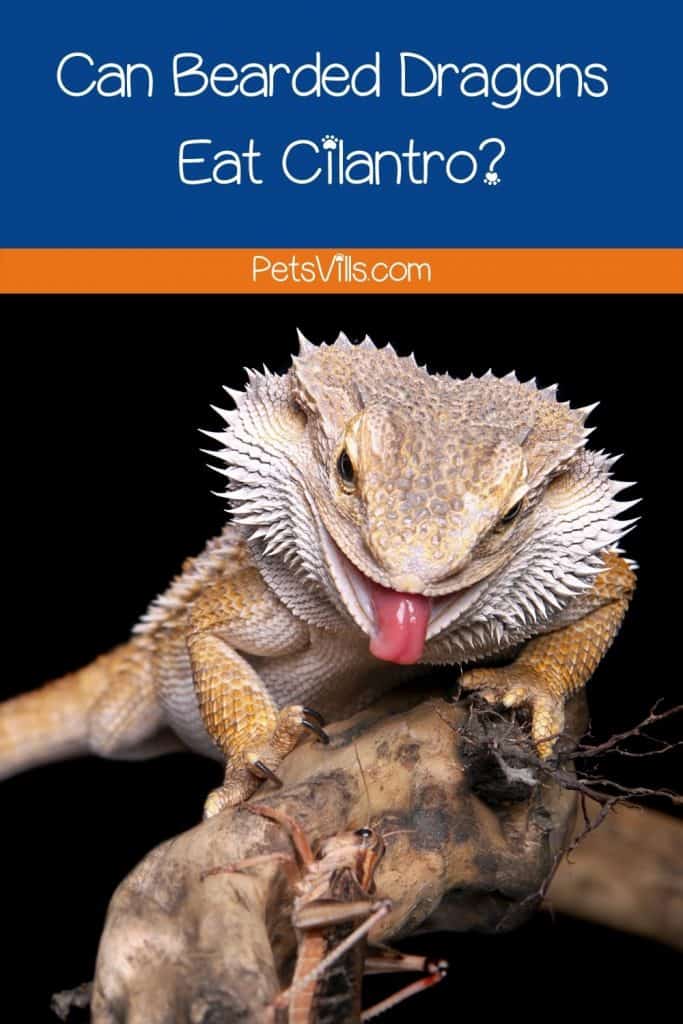
Can bearded dragons eat cilantro? Please share your thoughts in the comment section below!
Alina Hartley is a small-town girl with a ginormous love of bearded dragons. It all started with Winchester, a baby bearded who was abandoned at the shelter by his former owners because of a birth defect that caused one front leg to be shorter than the other. Alina originally went to the shelter looking for a guinea pig, but one look at Winchester and it was love at first sight. From that day on, Alina has dedicated her life to learning everything she can about bearded dragons. She loves helping new beardie parents start their incredible journey with these magnificent reptiles.
Follow her on:
LINKEDIN
TWITTER.
Read her latest articles HERE
Learn more about her HERE.

